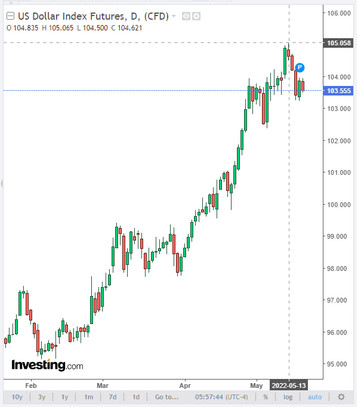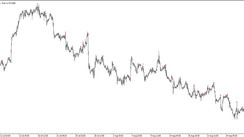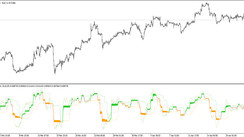Fed chief Jerome Powell on Tuesday reaffirmed the US central bank's commitment to an aggressive tightening of monetary policy. Speaking at the Wall Street Journal-sponsored Future of Everything festival, he said the Fed "has both the tools and the resolve to bring inflation under control" to 40-year highs. According to a report from the US Bureau of Labor Statistics, published on last week, the consumer price index (CPI) in April rose by +0.3% (+8.3% in annual terms), exceeding the growth forecast by +0.2% and +8.1%, respectively. Core CPI rose by +0.6% (+6.2% yoy), which was also better than expected, albeit lower than March values. The slowdown in annual inflation in April was the first easing in price pressures since August 2021. The data suggests that the Fed's more aggressive policy has been effective (at the end of the May meeting, Fed leaders decided to raise interest rates by 0.50% and announced the beginning of a reduction in the Fed's $9 trillion asset balance in June). inflation is still rising continues, albeit at a slower pace.
Obviously, the market was waiting for more aggressive statements by Powell. According to his own admission, the market has already taken into account the upcoming interest rate hikes at the next Fed meetings in prices. At the same time, Powell pointed out that avoiding a recession in the US will not be easy, and the restoration of price stability "may be associated with painful moments." “This is a really difficult task, which has become even more difficult in the last couple of months due to world events. The difficulty is that unemployment is already very low and inflation is very high," Powell said.
Yesterday, the most important inflationary indicators for Canada were published. According to the Canadian Bureau of Statistics, the consumer price index in the country in April rose by 6.8% (in annual terms) after rising by 6.7% in March with a neutral outlook. On a monthly basis, CPI rose by 0.6%, which was also higher than the forecast of growth of 0.5%.
According to the average indicator, calculated on the basis of core inflation, which does not take into account volatile food and energy prices, inflation rose to a 32-year high of 4.93% in April against 3.93% in March.
Excluding gasoline, annual inflation rose to 5.8% in April, the fastest growth in this category since 1999, with food and housing costs posting the highest increases in nearly 40 years.
Thus, core inflation in Canada is accelerating more rapidly than in the US. Canada's core consumer price index (CPI), which does not take into account volatile food and energy prices, has shown an increase of 6.9% per annum over the past three months against 5.7% in the US. April inflation data, released on Wednesday, virtually guarantees that the Bank of Canada will raise its key rate by half a percentage point following its meeting on June 1, economists say.
If the next meeting of the Bank of Canada is scheduled for June 1, and there is still intrigue about the further actions of the bank's management, then the next Fed meeting on monetary policy issues is scheduled for June 14-15.
In addition to having a 2-week time lag between the Bank of Canada and the Fed meetings, and both banks are expected to raise their interest rates by 0.50% at these meetings, the Canadian dollar, among other things, is receiving additional support from retaining potential to a further increase in oil prices (Canada is the largest oil producer, and its share in the country's exports is approximately 14% and 3% of GDP).
Last week, the Bank of Canada said that the rate remains "too stimulating, especially given that inflation is well above the upper limit of the target range" (1%-3%). Thus, the Bank of Canada has considerable room to maneuver when raising interest rates, and this is a strong fundamental factor that stimulates the growth of Canadian dollar quotes.
In our opinion, high volatility will remain in the quotes of the USD/CAD pair, not only until the Fed meeting in the middle of next month, but also after.
As for the US dollar, at the time of publication of this article, futures for the DXY dollar index were near 103.55, declining from the local maximum since January 2003 105.06, reached at the end of last week. Obviously, market participants expected more aggressive statements from Powell. And he only confirmed his own statements about monetary policy, made by him earlier.






